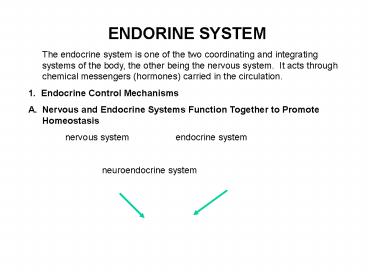ENDORINE SYSTEM PowerPoint PPT Presentation
1 / 27
Title: ENDORINE SYSTEM
1
- ENDORINE SYSTEM
- The endocrine system is one of the two
coordinating and integrating systems of the body,
the other being the nervous system. It acts
through chemical messengers (hormones) carried in
the circulation. - 1. Endocrine Control Mechanisms
- Nervous and Endocrine Systems Function Together
to Promote Homeostasis - nervous system endocrine system
- neuroendocrine system
2
(No Transcript)
3
- B. Hormones
- Definition
- A hormone can be defined as a chemical substance
which is synthesized and secreted by a specific
cell type, is transported in the circulation and
at very low concentrations elicits a specific
response in distant target tissues - Differences of endocrine, paracrine and autocrine
mechanisms - Classification
- peptide hormones, e.g. growth hormone, insulin
- steroid hormones, e.g. aldosterone, testosterone
- amino acid derivatives, e.g. thyroxine and
adrenaline
4
- Hormone synthesis and secretion
- synthesis of peptide hormones follow the same way
as protein synthesis - Precursors ? proteolytic cleavage ? peptide
hormones or proteins ? stored in vesicles ?
release upon appropriate stimulus into the blood - synthesis of steroid hormones
- Types of steroid hormones
- Glucocorticoids
- Mineralocorticoids
- Androgens
- estrogens
- progestins
5
(No Transcript)
6
A
B
C
7
- They all come from a common precursor
cholesterol - Once they are synthesized, they diffuse across
the cell membrane into the interstitial fluid
then into the blood so that their rate of release
is determined by their rate of synthesis. - synthesis and secretion of hormones from tyrosine
derivatives - Hormone transport and inactivation
- Once released into the blood stream,
lipid-soluble hormones, e.g. thyroid and steroid
hormones, are carried bound to various plasma
proteins. - Free form ?? bound form a dynamic equilibrium
8
(No Transcript)
9
(No Transcript)
10
- half-life of hormones minutes to days
- Inactivation may occur in the blood, in the
liver, or kidney, or in the target tissues. - Hormone actions
- membrane permeability
- activity of rate-limiting enzymes in reaction
pathways - protein synthesis
- gene activation leading to the transcription of
new mRNA species - Control of hormone secretion
- negative feedback mechanism
- positive feedback mechanism
11
- Mechanisms of Hormone Action
- second messenger model
- cyclic AMP
- inositol triphosphate (IP3 ) and diacyglycerol
(DG) - ions
- gene expression model
- The time of action for hormone using the two
models
12
(No Transcript)
13
(No Transcript)
14
(No Transcript)
15
(No Transcript)
16
- The two second messengers diacylglycerol (DAG)
and inositol triphosphate (IP3)
17
(No Transcript)
18
- 2. The Important Endocrine Glands and Their
Hormones - A. The pituitary hormones
- anatomy of the pituitary gland and its relation
to the hypothalamus - anterior lobe
- intermediate lobe
- posterior lobe
- pituitary stalk
- supraoptic neucleus
- paraventricular nucleus
- hypothalamus-pituitary portal system
- short portal system
19
(No Transcript)
20
- Regulation of pituitary hormone secretion by the
hypothalamus - secretion of posterior pituitary hormones a
typical neuroendocrine regulatory mechanism - secretion of anterior pituitary hormones a
typical endocrine regulatory mechanism - important releasing/inhibiting hormones produced
in hypothalamus - Corticotropin-releasing hormone (CRH)
- Thyrotropin-releasing hormone (TRH)
- Gonadotropin-releasing hormone (GnRH)
- Growth-hormone-releasing hormone (GHRH)
- Prolactin-releasing hormone (PRH)
- Prolactin-inhibitory hormone (PIH)
21
- Posterior pituitary hormones
- Antidiuretic hormone (ADH, vasppressin)
- chemistry 9 amino acid peptide, produced
primarily by supraoptic nucleus and small amount
by paraventricular nucleus - actions
- 1) water retention by the kidney ?
?urine volume and ? ECF - 2) vasoconstriction (in large amounts)
- regulation/stimuli
- 1) blood (or ECF) osmolality/osmoreceptors 2)
blood volume
22
- 3) others alcohol, nicotine, barbiturates, etc.
- abnormality diabetes insipidus
- Oxytocin
- chemistry 9 amino acid peptide, produced
primarily by paraventricular nucleus and small
amount by supraoptic nucleus - actions 1) regulating breast milk release
- 2) contraction of pregnant uterus
- regulation/stimuli
- suckling by a nursing infant
- crying sounds from a baby
- fear and stress inhibit release
23
- anterior pituitary hormones
- Growth hormone
- Prolactin
- Thyroid-stimulating hormone
- Adrenocorticotrophic hormone
- Folicle-stimulating hormone
- Luteinizing hormone
- Growth hormone (GH)
- chemistry191 peptide
- actions see Fig.13-7
- regulation/stimuli
- Growth hormone releasing hormone (GHRH)
24
(No Transcript)
25
(No Transcript)
26
- Growth hormone inhibitory hormone (somatostadin)
- other stimuli
- deep sleep
- low blood glucose
- stress
- amino acids (arginine)
- abnormality
- dwarfism
- gigantism (acromegaly)
27
(No Transcript)

